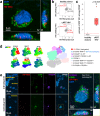S100A8-mediated metabolic adaptation controls HIV-1 persistence in macrophages in vivo
- PMID: 36220814
- PMCID: PMC9553955
- DOI: 10.1038/s41467-022-33401-x
S100A8-mediated metabolic adaptation controls HIV-1 persistence in macrophages in vivo
Abstract
HIV-1 eradication is hindered by viral persistence in cell reservoirs, established not only in circulatory CD4+T-cells but also in tissue-resident macrophages. The nature of macrophage reservoirs and mechanisms of persistence despite combined anti-retroviral therapy (cART) remain unclear. Using genital mucosa from cART-suppressed HIV-1-infected individuals, we evaluated the implication of macrophage immunometabolic pathways in HIV-1 persistence. We demonstrate that ex vivo, macrophage tissue reservoirs contain transcriptionally active HIV-1 and viral particles accumulated in virus-containing compartments, and harbor an inflammatory IL-1R+S100A8+MMP7+M4-phenotype prone to glycolysis. Reactivation of infectious virus production and release from these reservoirs in vitro are induced by the alarmin S100A8, an endogenous factor produced by M4-macrophages and implicated in "sterile" inflammation. This process metabolically depends on glycolysis. Altogether, inflammatory M4-macrophages form a major tissue reservoir of replication-competent HIV-1, which reactivate viral production upon autocrine/paracrine S100A8-mediated glycolytic stimulation. This HIV-1 persistence pathway needs to be targeted in future HIV eradication strategies.
© 2022. The Author(s).
Conflict of interest statement
The authors declare no competing interests.
Figures





Similar articles
-
Infectious Virus Persists in CD4+ T Cells and Macrophages in Antiretroviral Therapy-Suppressed Simian Immunodeficiency Virus-Infected Macaques.J Virol. 2019 Jul 17;93(15):e00065-19. doi: 10.1128/JVI.00065-19. Print 2019 Aug 1. J Virol. 2019. PMID: 31118264 Free PMC article.
-
Specific Activation In Vivo of HIV-1 by a Bromodomain Inhibitor from Monocytic Cells in Humanized Mice under Antiretroviral Therapy.J Virol. 2019 May 29;93(12):e00233-19. doi: 10.1128/JVI.00233-19. Print 2019 Jun 15. J Virol. 2019. PMID: 30971469 Free PMC article.
-
Reservoirs for HIV-1: mechanisms for viral persistence in the presence of antiviral immune responses and antiretroviral therapy.Annu Rev Immunol. 2000;18:665-708. doi: 10.1146/annurev.immunol.18.1.665. Annu Rev Immunol. 2000. PMID: 10837072 Review.
-
HIV Persistence in Adipose Tissue Reservoirs.Curr HIV/AIDS Rep. 2018 Feb;15(1):60-71. doi: 10.1007/s11904-018-0378-z. Curr HIV/AIDS Rep. 2018. PMID: 29423731 Free PMC article. Review.
-
Colony-Stimulating Factor 1 Receptor Antagonists Sensitize Human Immunodeficiency Virus Type 1-Infected Macrophages to TRAIL-Mediated Killing.J Virol. 2016 Jun 24;90(14):6255-6262. doi: 10.1128/JVI.00231-16. Print 2016 Jul 15. J Virol. 2016. PMID: 27122585 Free PMC article.
Cited by
-
HIV-1 inhibits IFITM3 expression to promote the infection of megakaryocytes.J Mol Cell Biol. 2025 Mar 21;16(9):mjae042. doi: 10.1093/jmcb/mjae042. J Mol Cell Biol. 2025. PMID: 39354676 Free PMC article.
-
Cholinergic Polarization of Human Macrophages.Int J Mol Sci. 2023 Oct 29;24(21):15732. doi: 10.3390/ijms242115732. Int J Mol Sci. 2023. PMID: 37958716 Free PMC article. Review.
-
S100A9 and HMGB1 orchestrate MDSC-mediated immunosuppression in melanoma through TLR4 signaling.J Immunother Cancer. 2024 Sep 11;12(9):e009552. doi: 10.1136/jitc-2024-009552. J Immunother Cancer. 2024. PMID: 39266214 Free PMC article.
-
Glycolytic metabolism: Food for immune cells, fuel for depression?Brain Behav Immun Health. 2024 Aug 14;40:100843. doi: 10.1016/j.bbih.2024.100843. eCollection 2024 Oct. Brain Behav Immun Health. 2024. PMID: 39263313 Free PMC article.
-
Epstein-Barr virus infection upregulates extracellular OLFM4 to activate YAP signaling during gastric cancer progression.Nat Commun. 2024 Dec 4;15(1):10543. doi: 10.1038/s41467-024-54850-6. Nat Commun. 2024. PMID: 39627192 Free PMC article.
References
Publication types
MeSH terms
Substances
LinkOut - more resources
Full Text Sources
Medical
Research Materials

